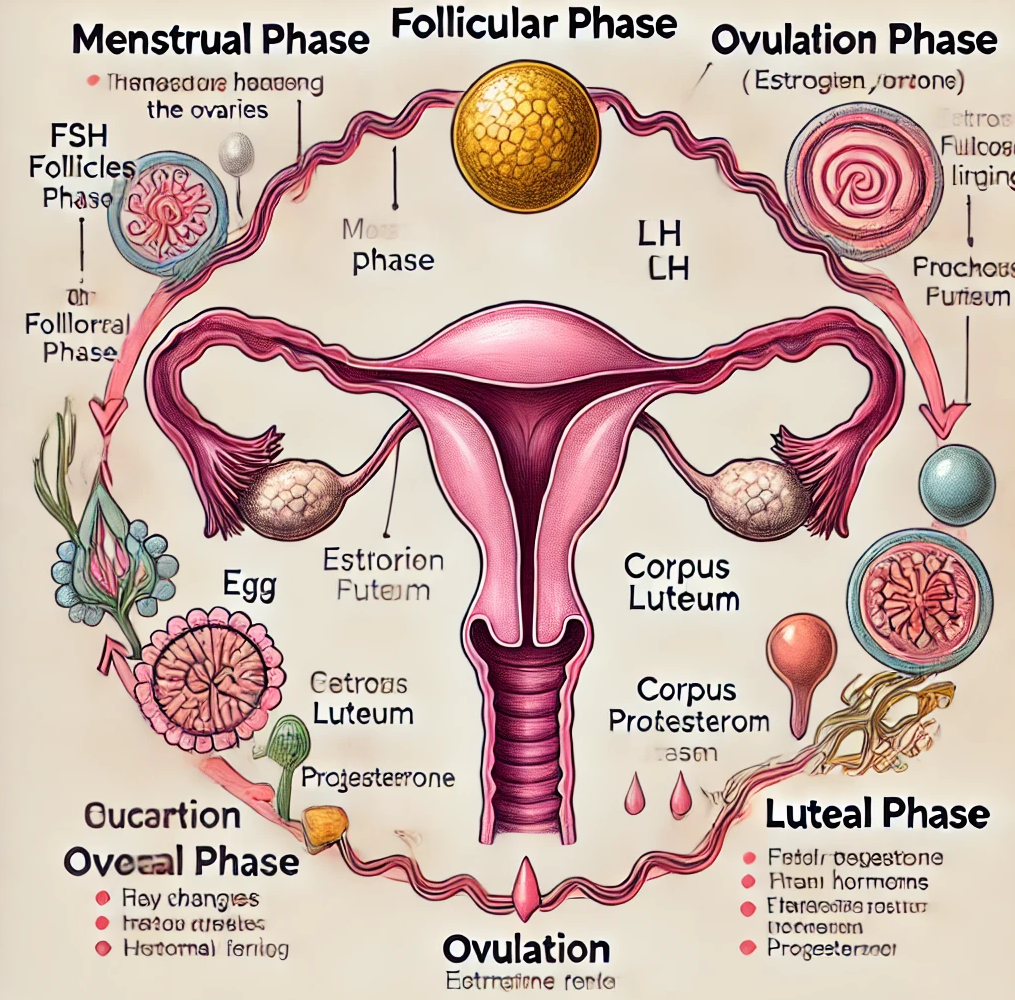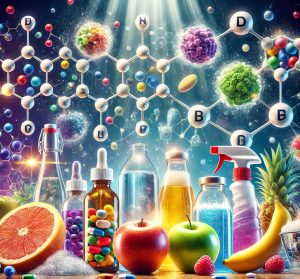The menstrual cycle is a monthly process that happens in a woman’s body, preparing it for pregnancy. It involves various changes in the uterus and ovaries, driven by hormones. A typical menstrual cycle lasts about 28 days, but it can vary from 21 to 35 days for different women. The cycle can be divided into several phases, each with its own purpose and physiological changes. Let’s break down the cycle in a simple way, focusing on the major events.
Overview of the Menstrual Cycle
The menstrual cycle has four main phases:
- Menstrual Phase (Days 1-5)
- Follicular Phase (Days 1-13)
- Ovulation (Day 14)
- Luteal Phase (Days 15-28)
1. Menstrual Phase (Days 1-5)
This phase is also called the period and is when bleeding occurs. If the egg from the previous cycle wasn’t fertilized, the lining of the uterus, called the endometrium, is shed, resulting in menstrual bleeding. This blood, along with tissue, exits the body through the vagina. Most women bleed for 3-5 days, but it can vary.
- What’s happening: The uterine lining that was thickened during the last cycle to support a pregnancy is no longer needed. Hormones like estrogen and progesterone are at their lowest, triggering the shedding of this lining.
- Example: Think of it like cleaning out an unused room that was prepared for a guest who didn’t arrive.
2. Follicular Phase (Days 1-13)
This phase overlaps with the menstrual phase in the beginning and lasts until ovulation. Here, the hormone follicle-stimulating hormone (FSH) is released from the brain, stimulating the ovaries to produce about 5 to 20 small sacs called follicles. Each follicle contains an immature egg.
As the phase progresses, only one follicle usually becomes dominant. The growing follicle releases estrogen, which helps thicken the uterine lining again in preparation for a possible pregnancy.
- What’s happening: The body is selecting one egg to mature while preparing the uterus for a future pregnancy.
- Example: Imagine this phase as the body cleaning and redecorating the guest room for a potential guest.
3. Ovulation (Day 14)
Ovulation is the midpoint of the cycle and typically happens around day 14, though it can vary depending on the cycle length. During ovulation, the dominant follicle releases a mature egg. The release of the egg is triggered by a surge of luteinizing hormone (LH).
Once the egg is released, it travels down the fallopian tube and remains there for about 12-24 hours, waiting for sperm to fertilize it. If fertilization occurs, pregnancy can happen. If not, the egg disintegrates.
- What’s happening: A mature egg is released from the ovary and is available for fertilization.
- Example: Imagine ovulation as the guest arriving, and now the door is open, waiting for them to enter.
4. Luteal Phase (Days 15-28)
After ovulation, the follicle that released the egg transforms into the corpus luteum, which produces progesterone. This hormone keeps the uterine lining thick and ready for a fertilized egg to implant. If the egg is fertilized and pregnancy begins, the body produces human chorionic gonadotropin (HCG) to maintain the corpus luteum.
If fertilization doesn’t happen, the corpus luteum breaks down, leading to a drop in progesterone and estrogen levels. Without these hormones, the uterine lining starts to shed, beginning the cycle again with the menstrual phase.
- What’s happening: The body either prepares to support a pregnancy or begins to return to the menstrual phase if pregnancy doesn’t occur.
- Example: Think of this phase as the guest room waiting for the guest. If the guest doesn’t arrive, everything is cleaned out and reset for the next possible guest.
Hormonal Control of the Menstrual Cycle
Four main hormones regulate the menstrual cycle:
- Follicle-Stimulating Hormone (FSH) – Stimulates the development of follicles in the ovaries.
- Luteinizing Hormone (LH) – Triggers ovulation and stimulates the production of progesterone.
- Estrogen – Produced by the follicles; thickens the uterine lining.
- Progesterone – Produced by the corpus luteum; maintains the uterine lining.
Changes in the Uterus
The uterus undergoes different changes during the cycle, particularly in its lining (the endometrium). The endometrium thickens during the follicular phase and remains thick during the luteal phase to support a potential pregnancy. If fertilization doesn’t happen, it sheds during menstruation.
Pregnancy and Menstrual Cycle
If the egg is fertilized by sperm, it travels to the uterus and implants into the thickened uterine lining. The fertilized egg becomes an embryo, and the body produces hormones that support pregnancy, including HCG, which prevents the shedding of the uterine lining.
If fertilization doesn’t occur, hormone levels drop, and the next menstrual period begins.
See in Fig:

Here is a Fig illustrating the different phases of the menstrual cycle: the menstrual phase, follicular phase, ovulation, and luteal phase. It shows the changes in the ovaries and uterus, along with the associated hormones like FSH, LH, estrogen, and progesterone. This visual should help in understanding the process clearly.
Questions and Answers related to the Menstrual Cycle and Human Reproduction
1. What is the menstrual cycle?
- Answer: The menstrual cycle is the monthly process in a woman’s body, where the lining of the uterus is prepared for a potential pregnancy. It consists of four phases: menstrual phase, follicular phase, ovulation, and luteal phase, lasting an average of 28 days.
2. What happens during the menstrual phase?
- Answer: During the menstrual phase (days 1-5), the uterine lining sheds, resulting in bleeding. This occurs because the egg from the previous cycle wasn’t fertilized, and the hormone levels (estrogen and progesterone) drop.
3. What triggers ovulation?
- Answer: Ovulation is triggered by a surge of luteinizing hormone (LH). This causes the release of a mature egg from the dominant follicle in the ovary, typically on day 14 of the cycle.
4. Which hormones are responsible for the regulation of the menstrual cycle?
- Answer: The menstrual cycle is regulated by four key hormones:
- Follicle-stimulating hormone (FSH)
- Luteinizing hormone (LH)
- Estrogen
- Progesterone
5. What is the role of the follicular phase?
- Answer: In the follicular phase (days 1-13), FSH stimulates the growth of several follicles in the ovary. One dominant follicle matures and releases estrogen, which thickens the uterine lining to prepare for a possible pregnancy.
6. What happens during the luteal phase?
- Answer: The luteal phase (days 15-28) occurs after ovulation. The follicle that released the egg becomes the corpus luteum, producing progesterone to maintain the uterine lining. If fertilization doesn’t happen, the corpus luteum degenerates, and the next cycle begins.
7. What is the function of estrogen in the menstrual cycle?
- Answer: Estrogen, produced by the follicles, helps in thickening the uterine lining (endometrium) during the follicular phase to prepare it for the implantation of a fertilized egg.
8. What is ovulation and when does it typically occur?
- Answer: Ovulation is the release of a mature egg from the ovary, typically around day 14 of a 28-day menstrual cycle. It is the period when a woman is most fertile and can conceive if sperm fertilizes the egg.
9. What happens if the egg is not fertilized?
- Answer: If the egg is not fertilized, the corpus luteum breaks down, leading to a drop in progesterone and estrogen. As a result, the thickened uterine lining sheds, beginning the next menstrual period.
10. What is the corpus luteum?
- Answer: The corpus luteum is the structure formed from the follicle after it releases an egg during ovulation. It produces progesterone to maintain the uterine lining for a potential pregnancy.
11. What is the average length of the menstrual cycle?
- Answer: The average menstrual cycle length is 28 days, but it can vary from 21 to 35 days depending on the individual.
12. What is the primary function of progesterone in the menstrual cycle?
- Answer: Progesterone is produced by the corpus luteum after ovulation. Its main function is to maintain the uterine lining in preparation for the implantation of a fertilized egg. If pregnancy does not occur, progesterone levels fall, triggering menstruation.






